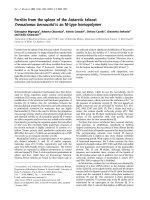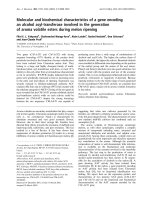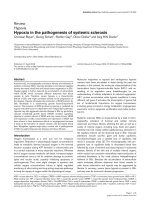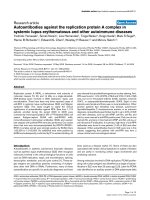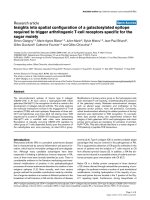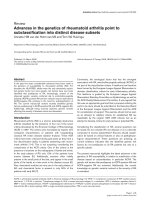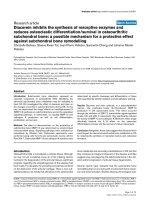Báo cáo y học: "Cough: meeting the needs of a growing field" ppt
Bạn đang xem bản rút gọn của tài liệu. Xem và tải ngay bản đầy đủ của tài liệu tại đây (176.26 KB, 2 trang )
BioMed Central
Page 1 of 2
(page number not for citation purposes)
Cough
Open Access
Editorial
Cough: meeting the needs of a growing field
Rubaiyat A Haque* and Kian Fan Chung
Address: Airways Disease Section, National Heart & Lung Institute, Imperial College, London, UK
Email: Rubaiyat A Haque* - ; Kian Fan Chung -
* Corresponding author
Abstract
There has been a rapidly increasing volume of research undertaken in the field of acute and chronic
cough at both basic scientific and clinical levels. However, until now there has been no journal
dedicated to publishing work in this field. In this editorial, we introduce the new online, open-access
journal entitled Cough which has been founded specifically for this purpose. We also review the
clinical problems posed by acute and chronic cough and highlight some of the current issues that
are being tackled by cough researchers.
A new journal for a modern era
Between 2000 and 2004, the number of PubMed entries
per year containing the keyword 'cough' has increased by
forty percent. This partially reflects a general increase in
the number of scientific publications over this period but
it also represents a specific growth in interest in cough-
related research. This interest spans a number of medical
and scientific disciplines other than respiratory medicine,
such as gastroenterology, rhinology, paediatrics, infec-
tious disease, pharmacology, neurology, neuroanatomy,
genetics, inflammation, etc. The need for a single journal
that brings together clinicians and scientists in all of these
disciplines with the aim of achieving a better understand-
ing of cough-related disease has been long overdue. So it
gives us great pleasure to welcome you to Cough. Besides
being the only journal to specialise in this particular area
of research, Cough is special for other reasons. Embracing
the modern era of information technology, Cough is an
entirely online journal. Our online submission system
allows for rapid review and revision of manuscripts and
when accepted, articles appear in the journal immedi-
ately. More significantly, Cough is an Open Access journal.
All articles are freely and universally accessible without
subscription. Authors of published articles retain the cop-
yright to their work and the full text of each article is per-
manently archived in PubMed Central. It will be of
interest to contributors that free online access can increase
the impact of a paper [1].
The problem of acute and chronic cough
Cough is a common symptom of many respiratory and
non-respiratory disorders. It is useful from a diagnostic
point of view to divide cough into acute (lasting less than
three weeks) and chronic (lasting longer than eight
weeks) types [2]. Acute cough is the most frequently
reported respiratory symptom and the commonest reason
for medical consultation. The majority of cases of acute
cough are due to upper respiratory viral infections. The
disease is self-limiting and symptoms usually subside
within a week. In this situation, cough is a short-lived
complaint and confers the important benefit of airway
protection and mucus clearance. However, there is a huge
demand for over-the-counter cough remedies (many of
which have little proven clinical benefit) and the amount
of consultation time taken up by this problem is difficult
to ignore. The acute viral infection-induced cough is an
irritation that most sufferers would rather do without and
effective antitussives are needed to address this.
Published: 04 August 2005
Cough 2005, 1:1 doi:10.1186/1745-9974-1-1
Received: 08 July 2005
Accepted: 04 August 2005
This article is available from: />© 2005 Haque and Chung; licensee BioMed Central Ltd.
This is an Open Access article distributed under the terms of the Creative Commons Attribution License ( />),
which permits unrestricted use, distribution, and reproduction in any medium, provided the original work is properly cited.
Publish with BioMed Central and every
scientist can read your work free of charge
"BioMed Central will be the most significant development for
disseminating the results of biomedical research in our lifetime."
Sir Paul Nurse, Cancer Research UK
Your research papers will be:
available free of charge to the entire biomedical community
peer reviewed and published immediately upon acceptance
cited in PubMed and archived on PubMed Central
yours — you keep the copyright
Submit your manuscript here:
/>BioMedcentral
Cough 2005, 1:1 />Page 2 of 2
(page number not for citation purposes)
Chronic cough, on the other hand, is a rather different ket-
tle of fish. It can arbitrarily be defined as lasting longer
than eight weeks but by the time these patients reach the
specialist cough centre, they have suffered for a median
duration of four years [3]. Chronic cough serves no obvi-
ous function. Persistent coughing has a profoundly detri-
mental effect on quality of life and can lead to social
isolation and clinical depression. It is all too easy to
attribute chronic cough to being a largely psychological
phenomenon when, in fact, in the majority of cases there
is a treatable cause. The commonest causes are generally
accepted to be gastro-oesophageal reflux disease (GORD),
rhinosinusitis and asthma. However, there is a significant
minority of sufferers whose cough evades all attempts at
diagnosis and treatment, earning them the label of
chronic idiopathic cough. Whether idiopathic cough is a
real condition or simply a failure of diagnosis continues
to be debated.
Current issues in cough research
So now that we have a forum in which cough researchers
of all disciplines can take part, what directions might be
taken by researchers in this field? At the level of both the
afferent and efferent limbs of the cough reflex, we are now
beginning to better understand the physiological and
pathophysiological reflex. The anatomo-physiological
approach to elucidating the cough reflex has led to the
description in the guinea pig of a vagal afferent nerve sub-
type as being essential for defensive cough [4]. The role of
other airway sensory receptors might be to modulate,
rather than initiate cough. Electrophysiological studies
combined with immunohistochemistry are uncovering a
heterogeneity of receptors and channels present on spe-
cialised receptors such as the cough receptors. Centrally,
the role of neurotransmitters such as tachykinins at the
level of the 'cough centre' may partially sensitise the cough
reflex. This is an important observation since patients
with chronic cough have an increased cough reflex sensi-
tivity as measured by capsaicin or citric acid challenge.
Such fundamental research raises the hope of an
improved understanding of the cough reflex and its sensi-
tisation and ultimately better target identification for
effective antitussives.
Clinical cough research is, in many ways, in its infancy.
Part of the reason for this might be, until relatively
recently, the lack of availability of tools that adequately
measure cough. For some time we have believed that
almost all patients with chronic cough can be cured by
systematically identifying and treating asthma, GORD
and rhinosinusitis. Yet there is little evidence that proton
pump inhibitors and nasal steroids have any real sus-
tained benefit in the treatment of acid- and postnasal
drip-associated cough. Sedating antihistamines combined
with decongestants are reported to be effective in the treat-
ment of cough due to rhinosinusitis but the benefits may
be of central origin and have little to do with postnasal
drip. Are our means of diagnosing these conditions ade-
quate? Are our treatments appropriate and genuinely
effective? There seems, anecdotally at least, to be a group
of chronic coughers who elude diagnosis and do not
respond to any specific treatment. These idiopathic
coughers form a significant proportion of patients in cer-
tain cough centres [3]. These patients are likely to have a
variety of as yet unidentified pathologies and are fertile
ground for future investigation.
Whatever directions are taken in the future by cough
researchers, the journey will no doubt be an exciting one.
The launch of Cough will help to keep us all better
informed of developments in this area and assist those in
the field in directing research endeavours. We would like
to thank the members of our Editorial Board for their will-
ingness to contribute both their time and expertise to this
project. We are all, of course, indebted to the staff at Bio-
Med Central for their invaluable assistance with this
launch.
Competing interests
A small proportion of article processing charges (APC)
from accepted manuscripts goes to the editorial office to
help with the running costs of the journal. Additional
costs have been met by an unconditional grant from
AstraZeneca.
References
1. Lawrence S: Free online availability substantially increases a
paper's impact. Nature 2001, 411:521.
2. Chung KF, Widdicombe J: Acute and chronic cough. Pulm Phar-
macol Ther 2004, 17:471-473.
3. Haque RA, Usmani OS, Barnes PJ: Chronic Idiopathic Cough: A
Discrete Clinical Entity? Chest 2005, 127:1710-1713.
4. Canning BJ, Mazzone SB, Meeker SN, Mori N, Reynolds SM, Undem
BJ: Identification of the tracheal and laryngeal afferent neu-
rones mediating cough in anaesthetized guinea-pigs. J Physiol
2004, 557:543-58.

